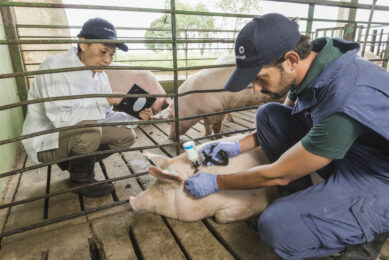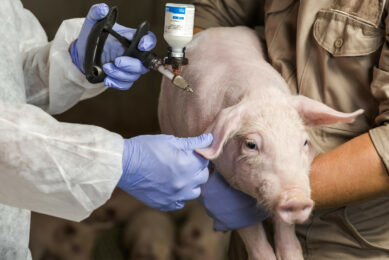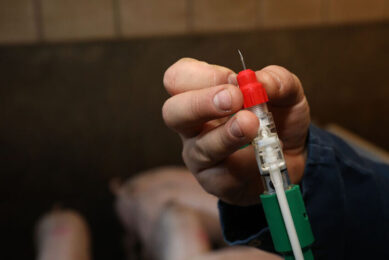Research updates support whole-herd vaccination
![Whole herd vaccination includes stabilising sow immunity as well as vaccinating piglets at weaning. [Photo: Boehringer Ingelheim]](https://www.pigprogress.net/app/uploads/2021/04/001_463_rb-image-2698480-848x565.jpeg)
PRRS is a viral disease that has been plaguing pig producers for more than two decades. As the virus recombines from time to time, being prepared counts more than anything. Whole herd vaccination with a modified live vaccine has proven its worth.
Across the world, pork producers and veterinarians are now looking at more than 25 years dealing with Porcine Reproductive and Respiratory Syndrome (PRRS). Even after this long period of time, PRRS remains probably the most important of all swine diseases for its economic impact. But recent scientific reports and publications about the disease have added significantly to the global fund of knowledge about vaccine efficacy and how to combat PRRS by vaccinating both sows and young pigs.
Genetic diversity
The ability of this RNA virus to mutate and recombine has meant the emergence of different sub-types from time to time. A vital aspect of modified live virus (MLV) vaccines for PRRS is therefore that they must be effective against newly emerging field isolates of the wild virus.
The continuing success of PRRSv vaccine in providing protection against this diversity was demonstrated again recently, in a trial reported at the 7th International Symposium on Emerging and Re-Emerging Swine Diseases, held in June 2015 in Kyoto, Japan. It was designed to check the protection offered by Ingelvac PRRS MLV to pigs challenged with multiple viral variants.
The trial examined pigs for lung lesions, after they had been vaccinated at about 21 days old and then exposed experimentally to different field viruses. Adding the results to those from previous studies gave an insight into the vaccine’s efficacy against eight genetically diverse PRRSv isolates. The conclusion from this extensive comparison was that the vaccine significantly reduced the percentage of lung lesions in all cases for the vaccinated pigs and demonstrated a clear advantage from using this MLV.
From sows to young pigs
PRRSv vaccines have been around for more than 20 years, but it is only quite recently that their practical application has been extended beyond the early target of stabilising sow immunity to include also vaccinating weaned pigs. The whole-herd approach started in the United States and has since been adopted in Denmark, Canada, Mexico and a number of Asian countries.
One of the latest examples of the potentially large economic benefit obtainable from this wider vaccine usage comes from South Korea. Details were given in another presentation to the Kyoto symposium, reporting a Korean study that had looked at administering the vaccine to growing pigs at a breeding-finishing farm of 400 sows. The vaccination was so successful in improving pig performance, it gave an average return on investment of 5.7:1.
This was in a two-site production system which had suffered a breakdown with wild-type virus at its grow-finish site after staying PRRS-free for some years. Vaccinating piglets minimised the impact of the infection and boosted growth performance and FCR.
Less shedding
Previously, piglet vaccination was often applied as a short-term measure to fight a particular outbreak. Helping to drive a different attitude today is that the tools for monitoring PRRSv have improved greatly, giving a much better perspective regarding the effect of vaccination on aspects such as the shedding of the wild virus by viraemic pigs.
A joint study by the Pipestone Group in the United States and Boehringer Ingelheim described how MLV vaccination at weaning led to less shedding of wild-type PRRSv into the air at the growing stage by the experimentally infected pigs, (Table 1).
The assessment divided over 2,000 PRRS negative pigs into two groups, one being vaccinated at four weeks old before 10% of each group was inoculated with wild-type viral material.
Wild virus were found significantly more often in the air outside the room holding non-vaccinated pigs while the duration of detection of viral RNA in air samples was numerically shorter in the vaccinated group.
Both of these observations indicate that the risk of PRRSv being transmitted through the air between herds in an area of high pig density can be reduced by modified-live vaccination of the growing pigs at risk of infection.
Experiences in regional control programmes provide considerable further evidence of the value of whole-herd MLV vaccination. Firstly, infection will be prevented in a higher proportion of the growing pigs. Secondly, even if some pigs do become infected, they will shed less into their environment.
Big numbers
Whole-herd vaccination with an MLV has the positive benefit of reducing the proportion of wild-type PRRSv in a production system as well as cutting death losses between birth and market. This was reported from the results of a massive study performed over 15 months at a multi-site American pork production network of 70,000 sows.
A first outline of this study was given at the International Pig Veterinary Society (IPVS) Congress of 2012. The records investigated before starting to vaccinate covered more than 3.6 million piglets in the nursery phase and 2.7 million finisher pigs. After-vaccination groups added 1.5 million nursery piglets and over one million pigs in the finishing barns.
Initially the whole breeding herd was vaccinated while it remained closed for 130 days. This was followed by quarterly vaccinations of sows and vaccination of all piglets at weaning. In total, from over 8.6 million pigs studied, results showed a significant increase in ADG and a significant fall in mortality rates compared with the herd’s performance in the previous 24 months, (Table 2).
| Table 2 – Analysis of system-wide close out gain and mortality before and after vaccination. |
| |
The recent update from Kyoto reported an in-depth analysis of the mortality figures from the project in relation to findings from intensive monthly diagnostic monitoring. Before vaccination started, all samples of the PRRS virus found in the system were of the wild type.
With the use of the vaccine, this proportion fell below 50%. It revealed a close relationship, with significantly fewer deaths occurring where there was a lower prevalence of wild-type virus in the total PRRSv viral load confronting the pigs.
Double value
A key point from the combined research updates must be that although PRRS remains a costly and largely unresolved problem caused by a variable pathogen, at the same time it is clear that vaccination protects against a wide range of PRRSv strains. Moreover, evidence is mounting that applying it on an whole-herd approach, brings double value. It leads to better growth performance and lower birth-to-market death losses. At the same time, it reduces viraemia and the shedding of wild-type PRRSv, so ensuring that the pigs face less of a challenge to their health and well-being.
References are available from the authors upon request.






